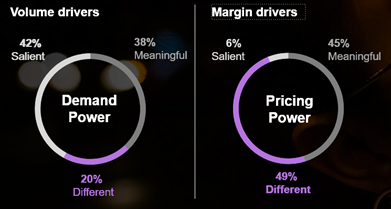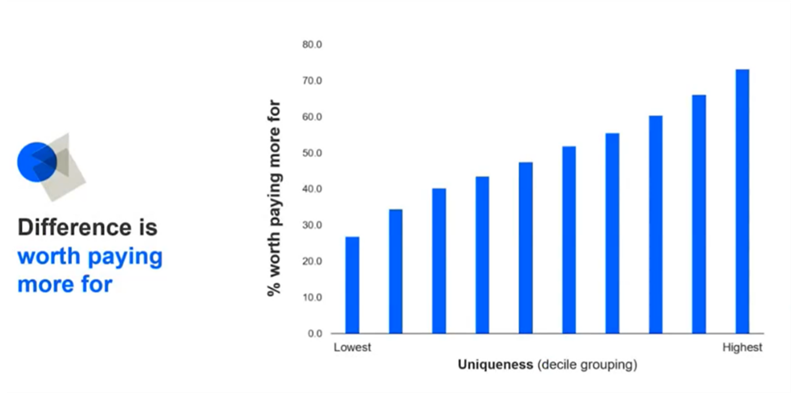What’s the case for building a brand that’s Different?
Does your brand offer unique value that consumers are willing to pay for? Often, they’re unlikely to say so. But beyond this instinctive and rational dismissal of brand Differentiation, marketers are well aware of a powerful commercial opportunity that, if unlocked, can predispose people to choose a product or service more frequently, and pay significantly more than a competitor offering.
Those familiar with Kantar’s Meaningfully Different and Salient Framework will be aware of the profound importance of ‘Difference.’ This is also emphasised by industry expert, Mark Ritson, who delivered compelling argument in favour of the benefits of Difference as a complementary focus to Distinctiveness at Kantar’s flagship IGNITE event last year. The relationship between a brand’s Difference—as measured by how dynamic and unique it is relative to brands in the category—and the overall Power of the brand in driving commercial performance and growth cannot be overlooked. This matters for all brands.
For emerging brands, Difference can drive sales and propel them to become mainstream brands while for more established brands, it is often the key in unlocking Pricing Power. Our data shows that in addition to being a core component in shaping a brand’s ability to drive volume—Demand Power—Difference is the most critical factor of what allows brands charge a premium in their category—Pricing Power.

The potential commercial value of Pricing Power is huge – brands that can deliver on Difference, can double the price consumers are willing to pay. The evidence stacks up that Difference is worth paying more for – so it’s an imperative for brands who want to unlock maximum value and avoid leaving money on the table.

Source: Kantar BrandZ data
The Brand Structures framework delivers a dual solution; understanding the direct levers to influence, and the indirect levers to activate against to drive brand Difference. Taking this a step further, simulation modelling can guide realistic KPI setting to build strategic plans that drive future growth.
Are consumers still willing to pay a premium in uncertain times?
Despite some modest improvements in the economy, consumers are still feeling inflationary pressures and uncertainty about their personal finances. But research shows us that in circumstances where consumers are not only reducing spending, and limit their choices to make well-informed purchasing decisions, pricing becomes a critical factor making pricing. Whilst a brand's equity and image are significant, pricing emerges as a vital factor in consumer decision-making.
When Difference is difficult.
For some brands, the approach to being Different is obvious, explicit and intuitive. Think Tesla, TikTok or Red Bull—with its distinctive cartoon-style advertising and sponsoring of extreme events (anyone for cliff diving or aerobatic flying?) and recent product innovations like the new cactus-fruit flavoured drink. But the challenge to build credentials of Difference requires understanding which positioning will most effectively and credibly work for your brand. Chasing the same route to Differentiation as category competitors is unlikely to pay off in a climate where marketing budgets and resources are constrained. So how can you be confident in developing a strategy around differentiating your brand that will pay off and deliver commercial return?
Smart prioritisation is the short answer. Identifying the most effective path to growth—the strategic levers that will create the right emotional connections and drive brand preference—is crucial for maximising your return on investment.
Kantar’s approach is rooted in the consumer perspective, but crucially extends beyond direct feedback to uncover the implicit mechanisms shaping brand perceptions.
The starting point: a bespoke analysis of the direct and indirect relationships between brand associations. Using a range of statistical techniques, a conceptual map of current drivers of brand equity and areas for effective intervention. This approach reveals how to influence powerful but intangible brand values like trust, value, or quality by identifying the levers that underpin them and the tactical steps to most impactfully drive a brand’s unique identity and equity.
This Brand Structures framework delivers a dual solution; understanding the direct levers to influence, and the indirect levers to activate against to drive brand Difference. Taking this a step further, simulation modelling can guide realistic KPI setting to build strategic plans that drive future growth.
The BrandStructures framework in action
A well-trusted financial services brand in the UK had been suffering a long-term decline in Brand Consideration and the marketing team were lacking clarity in where to best focus to resonate effectively across different consumer life stages. The Brand Structures analysis identified the most appropriate levers to be activated in context of the brand’s emotive positioning.
Typically, traditional analysis of brand imagery does not prove the ‘how’ for delivering on the more emotional brand outcomes like for example, trust, that prove so pivotal in influencing consumers’ choice. However, here, we could pinpoint the importance of ‘accessibility and convenience’ as a key mechanism to deliver on higher emotive outcomes and ultimately consideration among younger audiences.
In summary…
No doubt you already have a good understanding of where your brand currently sits and the top-level routes to growth. The Brand Structures framework can help you go deeper to understand how to translate the commercial growth ambitions into tangible, tactical actions. By embracing the nuanced concept of Difference, Kantar empowers organisations to navigate the intricacies of brand building with precision and efficacy in an ever-evolving competitive landscape.
Three things for you to consider:
- Focus on Difference: what do you already know from your customer insights about how you are perceived as Different versus your competitors? Is Difference a relative strength or weakness currently, and what’s driving those perceptions?
- Get curious: keep an eye on what other brands are doing to stand out in your category and seek inspiration more widely, to take inspiration from other sectors. Download Kantar’s latest BrandZ report for free for case studies of how the world’s most valuable brands are leveraging their Difference.
- Make it a priority: develop a plan around optimising your Difference. Get in touch if you’d like more information about Kantar’s BrandStructures framework and an assessment of how it could work for your brand.
Want your brand to benefit from understanding consumer needs to help with brand growth? Please get in touch with Renita Jude, Commerical Strategy Manager, Kantar.


